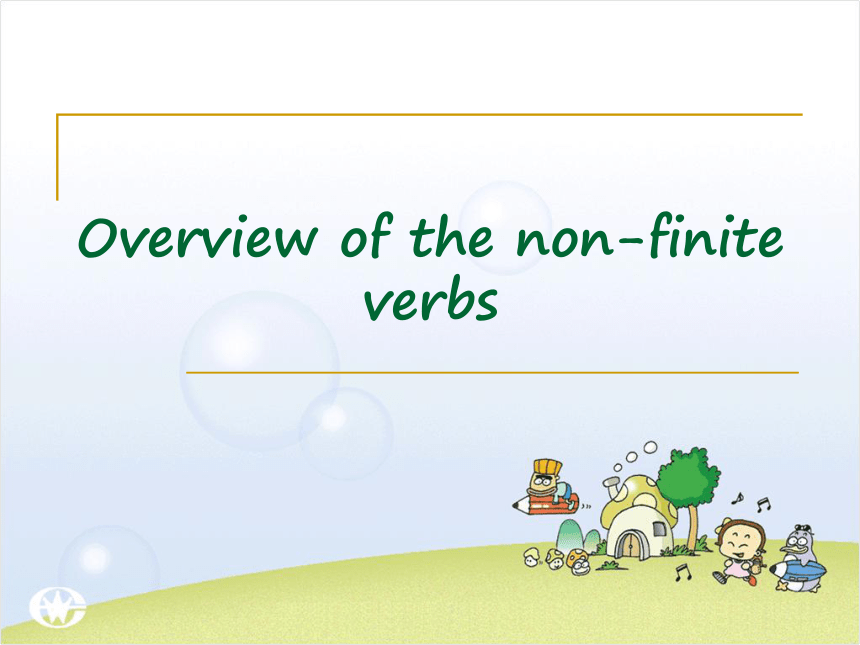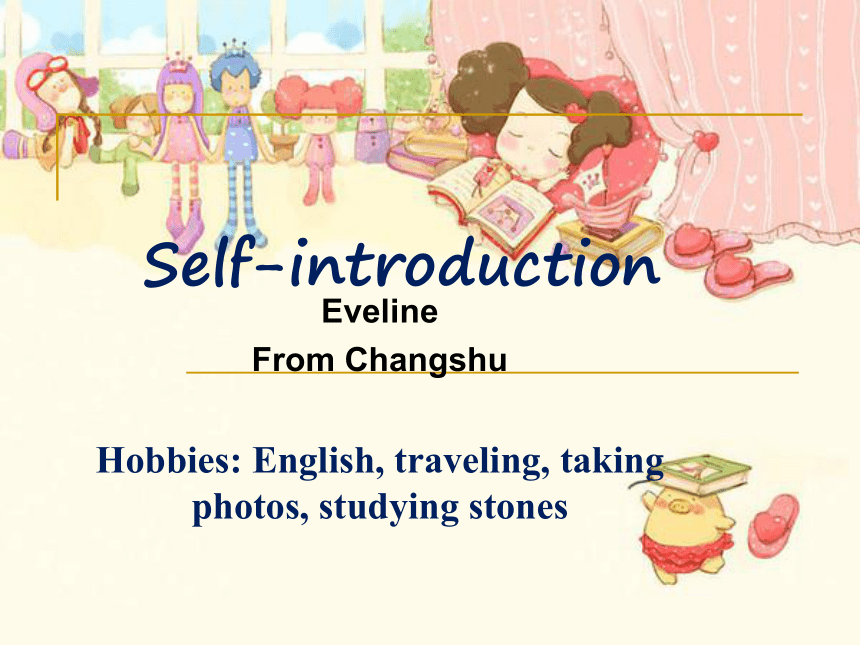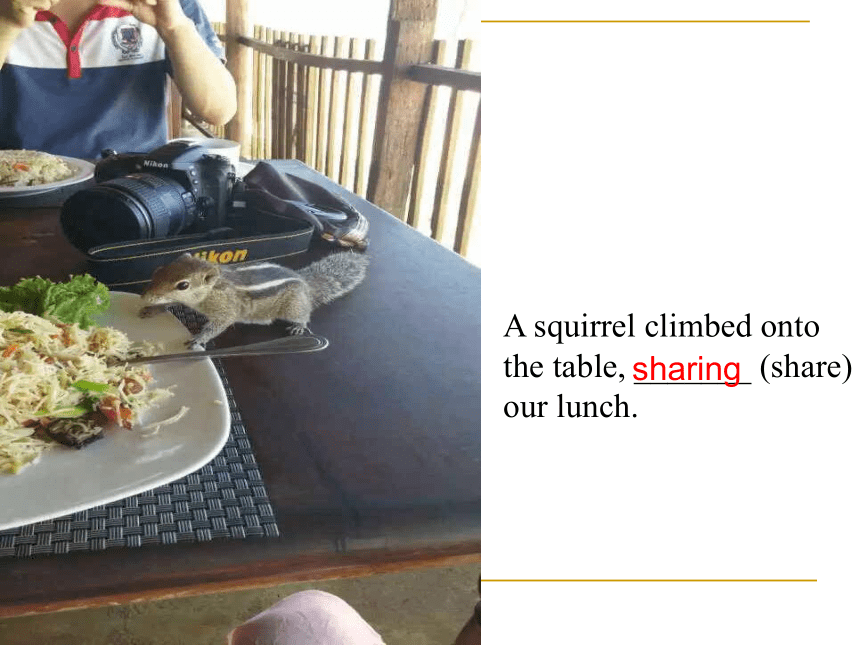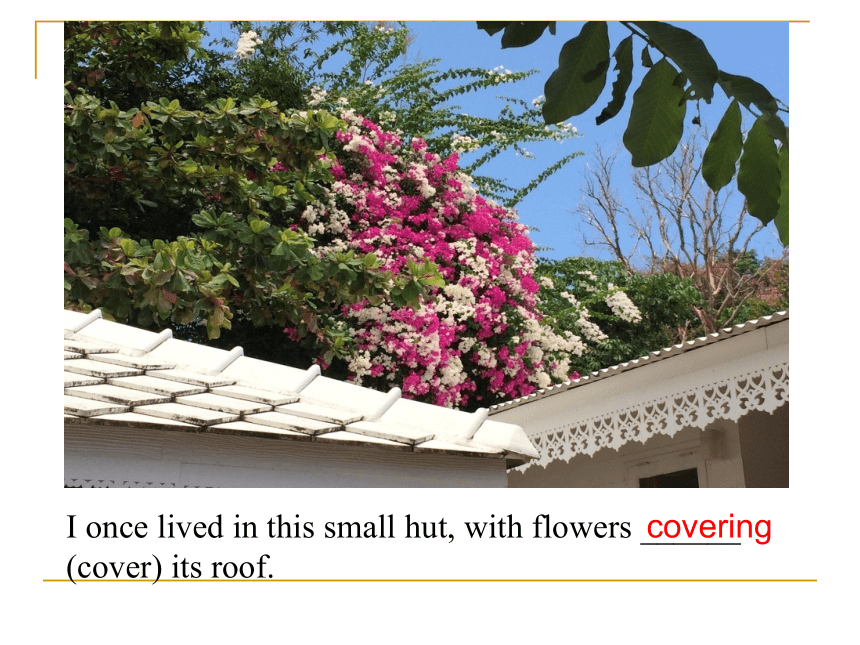模块6 Unit 1 Laughter is good for you Grammar and usage(1)课件(45张幻灯片)
文档属性
| 名称 | 模块6 Unit 1 Laughter is good for you Grammar and usage(1)课件(45张幻灯片) |  | |
| 格式 | zip | ||
| 文件大小 | 10.9MB | ||
| 资源类型 | 教案 | ||
| 版本资源 | 牛津译林版 | ||
| 科目 | 英语 | ||
| 更新时间 | 2019-07-28 22:09:13 | ||
图片预览












文档简介
课件45张PPT。Overview of the non-finite verbsSelf-introduction Eveline
From Changshu
Hobbies: English, traveling, taking photos, studying stones After ________(watch) the performance, we took a photo with the artists.watchingThese students, _______(wear) a big smile , were having a school outing that day.wearingThe newly-weds are taking wedding pictures, ________(wish) for a good future.wishingA squirrel climbed onto the table, _______ (share) our lunch.sharingWe climb onto the pickup _______ ( pick) some fresh fruits from the tree.to pick_______________ (bargain) with the shop owner ,I bought some fresh fish for barbecue. Having bargainedI once lived in this small hut, with flowers ______ (cover) its roof.coveringAll the tourists sat on the ship deck, _________ (prepare) for a whale watching in the Indian Ocean.prepared_________( sit) close to the handsome young pilot on the plane, we wore a big smile on our face.Sitting ________ (compare) with this young lady, my skin appeared fairer. Compared __________ (get) a better knowledge of history, I consulted the official _________(work) in the museum.To getworking__________ (not know)the way to my tourist spot, I asked for help from a local and he gave me a hand ________ (draw) map.Not knowingdrawnMany diamond dealers sent stones for me ________ (check) their quality.to checkAt dawn, I stood on the seashore, ________ (listen) to the wave ________ (beat) the sand. listeningbeatingoverview :Infinitive(不定式)
verb-ing(现在分词或动名词)
verb-ed (过去分词)class 7Learning objectives:
1 . Review and learn some techniques of non-finite verbs usage
2. Learn to apply non-finite verbs to multiple choices and reading comprehensions
3. Increase the awareness of using non-finite verbs in writingForms of non-finite verbs: the to infinitive(不定式)to doto be doneto have doneto have been doneto be doingto have been doing// V-ing(present participle)doingbeing donehaving donehaving been done V-ed (past participle)
Note“not” must be put before the non-finitenot +to do
doing
donedone V-ing (gerund) doing being done sb’s doing Special structure: conjunctions + V-ing /v-edWhen
While
If
Unless
Once
Though
Although
Even if
…
waiting, he recited some English words
instructed, no one knows how to operate the machine.
finished, this building will be used as a hospital.
taught many times, the little boy still can’t solve the math problems.
before/afterdoingbeing doneAfter being operated, this patient pulled through.Practice makes perfect:non-finite verbs in the multiple choices Step 1. Analyze the sentence structure and decide whether to use finite or non-finite Combine the following two sentences into one according to the requirement:?
Mary is clever. She learns English well.
________Mary is clever, she learns English well (adverbial clause of reason)
Mary is clever, __________ she learns English well. (adverbial clause of result)
Mary is clever __________ she learns English well. (compound complex sentence)
Mary is clever, ___________ learns English well.(attributive clause )
___________ clever, Mary learns English well.
Mary is clever, _____________ English well.Because soandwhoBeing learningPay special attention to coma(,) when dealing with the non-finite verbs.1._____many times , but he still couldn't understand it . 2. _____many times , he still couldn't understand it . A. Having been told B. Told C. He was told D. Though had been told
3. ______to the left , you'll find the post office . 4. If you _____to the left , you'll find the post office . 5. ______to the left and you'll find the post office . A. Turning B. To turn
C. Turn D. TurnedDistinguish finite or non-finiteC A A C C The one who takes action or bears action is called logical subject. Step 2. Analyze the logical subject of the non-finite verb. 6. First ____ to the market, these products enjoyed great success. A. introducing B. introduced C. introduce D. being introduced
7. While watching the TV, _____________________.
the doorbell rang.
the doorbell rings.
we heard the doorbell ring.
we heard the doorbell rang. CBIf the logical subject isn’t the subject of the sentence, we have to keep this logical subject. Structure like this is called absolute structure, or we say 独立主格结构8._______no buses , we had to walk home.
9. ______Sunday, I shall have a quiet day at home .
A. There being B. It was C. There were D. It being ADStep 3. Analyze the voice of the non-finite verb, active or passive voice. After deciding the logical subject, if this subject takes action, we use active voice. If the subject bears action, we use passive voice.10.______from space , the earth looks blue.
11.______from space , we can see the earth is blue A. Seen B. Seeing C. To see D. See12. The dirty clothes ____ , the girl hung them up outside.
13. ____ the dirty clothes ,the girl hung them up outside
A. was washed B. washed C. were washed D. having washedABDB 14. The building ______now will be a restaurant . 15. The building ______next year will be a restaurant . 16. The building ______last year is a restaurant.
A. having built B. to be built C. being built D. built。Step 4. Analyze tense of the non-finite verb, present, past or future?DBCIf there are adverbial of tense or two verbs happen at different time, we should consider applying tense to non-finite verbs. 二、找逻辑主语四、分析时态(时间关系)三、分析语态(主被动关系)一、辨别“谓与非谓”非谓语动词解题方法Practice makes perfect:non-finite verbs in readingsRead the passage and underline the sentences with non-finite verbs.
Pair work: Check whether you’ve got the right answers and try to figure out their functions in the sentences. When faced with that question, I’ ve been struck with
indecision and experienced pains of guilt if I passed by without giving a coin or two. Outside the café was an old woman kneeling on the ancient cobbled stones, begging.A lone young back-packer stood away from the crowd drinking something.adverbial of timeadverbial of manneradverbial of manneradverbial of mannerShe knelt motionless, her head almost touching the ground, a shabby scarf providing little protection against the cold. The sight was especially heart-breaking when contrasted with the visible signs of Venetian wealth, both past and present, around her.Then, as I prepared to leave, I stopped at the sight of the backpacker stepping forward and placing some money in the woman’s cup. Having been shown the way, other tourists followed suit and added more coins to the woman’s cup.absolute structure acting as adverbial of manneradverbial of timeadverbial of manneradverbial of timeThe young backpacker repeated this process in front of the next tour party going past.His work done, the young man walked over to the old beggar woman, patted her shoulder and said, “I hope that helps a bit.”I placed some money in the woman’s cup and continued my travels, light-hearted after witnessing such a smart act of caring.attributiveadverbial of timeadverbial of manner and timePractice makes perfect:non-finite verbs in English essaysSkill 1: Use non-finite to polish up sentences in our writing.1. Last weekend, 25-year-old Betty went up the mountain_________________________.
2. ______________________________________, she learnt quickly.
3. ____________________________________, she decided too practice on her own.
4. She fell on the ground _________________, but did not show signs of injury until an hour later.
5. __________________________, the ski instructor still followed strict procedures and insisted she should see a doctor.to learn how to ski.Accompanied by an experienced ski instructorThinking that she knew how to ski wellwhile skiing downhillAlthough not expecting trouble6. _____________________________________, Betty was sent to a larger one in the city.
7. _____________________ , Betty’s family felt very upset and worried.
8. ____________________________________, Betty’s family hurried to the hospital.
9. __________________________, they headed directly for the doctor’s office.
10. To their relief, the doctor told them that ___________________,Betty could recover soon.After being checked at the nearest hospitalWhen hearing the newsNot knowing how serious the situation wasUpon/On arrival at the hospitalif properly treatedSkill 2: Use non-finite to summarize the passage to save words.读写任务 阅读paving the way,然后按照要求写一篇150词左右的英语短文。【写作内容】 1、以约30词概括上文的主要内容
2、以约120词谈谈你阅读了该故事后的感受,内容包括: (1) 你如何看待这个年轻人的做法? (2) 如果你当时也在场,你会怎么做? (3) 你对整个事件作如何评价? A summary is a shortened passage which keeps the important information of the original in your own words but without your opinion. What is a summary?Common problems1. too many details
2. copying original sentences
3. exceeding the word limit
4. …Elements of the passage(要素串联法)A winter in 2006.Young man , the beggar& touristsan old woman begged in the cold wind, and a young man used his wisdom to help her.He influenced tourists so that tourists gave money to the woman beggar.Young man used psychological trick.On the Venice streetCombine 3 elements using your own words with the help of non-finite verbs.Show time ! An old woman knelt down on the road, begging, with tourists bustling past her. A young man used a trick to influence the tourists to help her, offering some support in the cold winter.Sample: Homework:
Finish the rest of the composition.
From Changshu
Hobbies: English, traveling, taking photos, studying stones After ________(watch) the performance, we took a photo with the artists.watchingThese students, _______(wear) a big smile , were having a school outing that day.wearingThe newly-weds are taking wedding pictures, ________(wish) for a good future.wishingA squirrel climbed onto the table, _______ (share) our lunch.sharingWe climb onto the pickup _______ ( pick) some fresh fruits from the tree.to pick_______________ (bargain) with the shop owner ,I bought some fresh fish for barbecue. Having bargainedI once lived in this small hut, with flowers ______ (cover) its roof.coveringAll the tourists sat on the ship deck, _________ (prepare) for a whale watching in the Indian Ocean.prepared_________( sit) close to the handsome young pilot on the plane, we wore a big smile on our face.Sitting ________ (compare) with this young lady, my skin appeared fairer. Compared __________ (get) a better knowledge of history, I consulted the official _________(work) in the museum.To getworking__________ (not know)the way to my tourist spot, I asked for help from a local and he gave me a hand ________ (draw) map.Not knowingdrawnMany diamond dealers sent stones for me ________ (check) their quality.to checkAt dawn, I stood on the seashore, ________ (listen) to the wave ________ (beat) the sand. listeningbeatingoverview :Infinitive(不定式)
verb-ing(现在分词或动名词)
verb-ed (过去分词)class 7Learning objectives:
1 . Review and learn some techniques of non-finite verbs usage
2. Learn to apply non-finite verbs to multiple choices and reading comprehensions
3. Increase the awareness of using non-finite verbs in writingForms of non-finite verbs: the to infinitive(不定式)to doto be doneto have doneto have been doneto be doingto have been doing// V-ing(present participle)doingbeing donehaving donehaving been done V-ed (past participle)
Note“not” must be put before the non-finitenot +to do
doing
donedone V-ing (gerund) doing being done sb’s doing Special structure: conjunctions + V-ing /v-edWhen
While
If
Unless
Once
Though
Although
Even if
…
waiting, he recited some English words
instructed, no one knows how to operate the machine.
finished, this building will be used as a hospital.
taught many times, the little boy still can’t solve the math problems.
before/afterdoingbeing doneAfter being operated, this patient pulled through.Practice makes perfect:non-finite verbs in the multiple choices Step 1. Analyze the sentence structure and decide whether to use finite or non-finite Combine the following two sentences into one according to the requirement:?
Mary is clever. She learns English well.
________Mary is clever, she learns English well (adverbial clause of reason)
Mary is clever, __________ she learns English well. (adverbial clause of result)
Mary is clever __________ she learns English well. (compound complex sentence)
Mary is clever, ___________ learns English well.(attributive clause )
___________ clever, Mary learns English well.
Mary is clever, _____________ English well.Because soandwhoBeing learningPay special attention to coma(,) when dealing with the non-finite verbs.1._____many times , but he still couldn't understand it . 2. _____many times , he still couldn't understand it . A. Having been told B. Told C. He was told D. Though had been told
3. ______to the left , you'll find the post office . 4. If you _____to the left , you'll find the post office . 5. ______to the left and you'll find the post office . A. Turning B. To turn
C. Turn D. TurnedDistinguish finite or non-finiteC A A C C The one who takes action or bears action is called logical subject. Step 2. Analyze the logical subject of the non-finite verb. 6. First ____ to the market, these products enjoyed great success. A. introducing B. introduced C. introduce D. being introduced
7. While watching the TV, _____________________.
the doorbell rang.
the doorbell rings.
we heard the doorbell ring.
we heard the doorbell rang. CBIf the logical subject isn’t the subject of the sentence, we have to keep this logical subject. Structure like this is called absolute structure, or we say 独立主格结构8._______no buses , we had to walk home.
9. ______Sunday, I shall have a quiet day at home .
A. There being B. It was C. There were D. It being ADStep 3. Analyze the voice of the non-finite verb, active or passive voice. After deciding the logical subject, if this subject takes action, we use active voice. If the subject bears action, we use passive voice.10.______from space , the earth looks blue.
11.______from space , we can see the earth is blue A. Seen B. Seeing C. To see D. See12. The dirty clothes ____ , the girl hung them up outside.
13. ____ the dirty clothes ,the girl hung them up outside
A. was washed B. washed C. were washed D. having washedABDB 14. The building ______now will be a restaurant . 15. The building ______next year will be a restaurant . 16. The building ______last year is a restaurant.
A. having built B. to be built C. being built D. built。Step 4. Analyze tense of the non-finite verb, present, past or future?DBCIf there are adverbial of tense or two verbs happen at different time, we should consider applying tense to non-finite verbs. 二、找逻辑主语四、分析时态(时间关系)三、分析语态(主被动关系)一、辨别“谓与非谓”非谓语动词解题方法Practice makes perfect:non-finite verbs in readingsRead the passage and underline the sentences with non-finite verbs.
Pair work: Check whether you’ve got the right answers and try to figure out their functions in the sentences. When faced with that question, I’ ve been struck with
indecision and experienced pains of guilt if I passed by without giving a coin or two. Outside the café was an old woman kneeling on the ancient cobbled stones, begging.A lone young back-packer stood away from the crowd drinking something.adverbial of timeadverbial of manneradverbial of manneradverbial of mannerShe knelt motionless, her head almost touching the ground, a shabby scarf providing little protection against the cold. The sight was especially heart-breaking when contrasted with the visible signs of Venetian wealth, both past and present, around her.Then, as I prepared to leave, I stopped at the sight of the backpacker stepping forward and placing some money in the woman’s cup. Having been shown the way, other tourists followed suit and added more coins to the woman’s cup.absolute structure acting as adverbial of manneradverbial of timeadverbial of manneradverbial of timeThe young backpacker repeated this process in front of the next tour party going past.His work done, the young man walked over to the old beggar woman, patted her shoulder and said, “I hope that helps a bit.”I placed some money in the woman’s cup and continued my travels, light-hearted after witnessing such a smart act of caring.attributiveadverbial of timeadverbial of manner and timePractice makes perfect:non-finite verbs in English essaysSkill 1: Use non-finite to polish up sentences in our writing.1. Last weekend, 25-year-old Betty went up the mountain_________________________.
2. ______________________________________, she learnt quickly.
3. ____________________________________, she decided too practice on her own.
4. She fell on the ground _________________, but did not show signs of injury until an hour later.
5. __________________________, the ski instructor still followed strict procedures and insisted she should see a doctor.to learn how to ski.Accompanied by an experienced ski instructorThinking that she knew how to ski wellwhile skiing downhillAlthough not expecting trouble6. _____________________________________, Betty was sent to a larger one in the city.
7. _____________________ , Betty’s family felt very upset and worried.
8. ____________________________________, Betty’s family hurried to the hospital.
9. __________________________, they headed directly for the doctor’s office.
10. To their relief, the doctor told them that ___________________,Betty could recover soon.After being checked at the nearest hospitalWhen hearing the newsNot knowing how serious the situation wasUpon/On arrival at the hospitalif properly treatedSkill 2: Use non-finite to summarize the passage to save words.读写任务 阅读paving the way,然后按照要求写一篇150词左右的英语短文。【写作内容】 1、以约30词概括上文的主要内容
2、以约120词谈谈你阅读了该故事后的感受,内容包括: (1) 你如何看待这个年轻人的做法? (2) 如果你当时也在场,你会怎么做? (3) 你对整个事件作如何评价? A summary is a shortened passage which keeps the important information of the original in your own words but without your opinion. What is a summary?Common problems1. too many details
2. copying original sentences
3. exceeding the word limit
4. …Elements of the passage(要素串联法)A winter in 2006.Young man , the beggar& touristsan old woman begged in the cold wind, and a young man used his wisdom to help her.He influenced tourists so that tourists gave money to the woman beggar.Young man used psychological trick.On the Venice streetCombine 3 elements using your own words with the help of non-finite verbs.Show time ! An old woman knelt down on the road, begging, with tourists bustling past her. A young man used a trick to influence the tourists to help her, offering some support in the cold winter.Sample: Homework:
Finish the rest of the composition.
